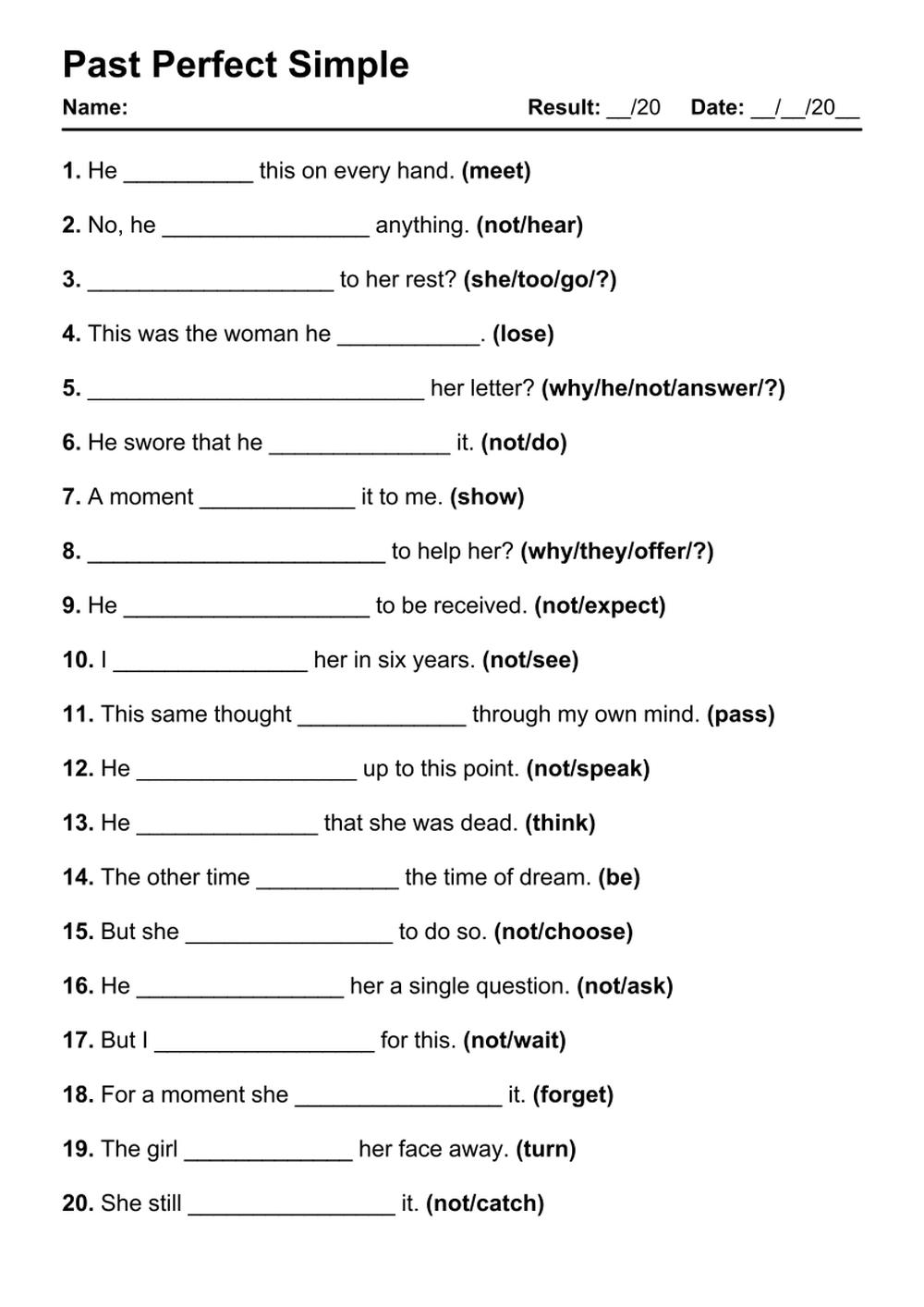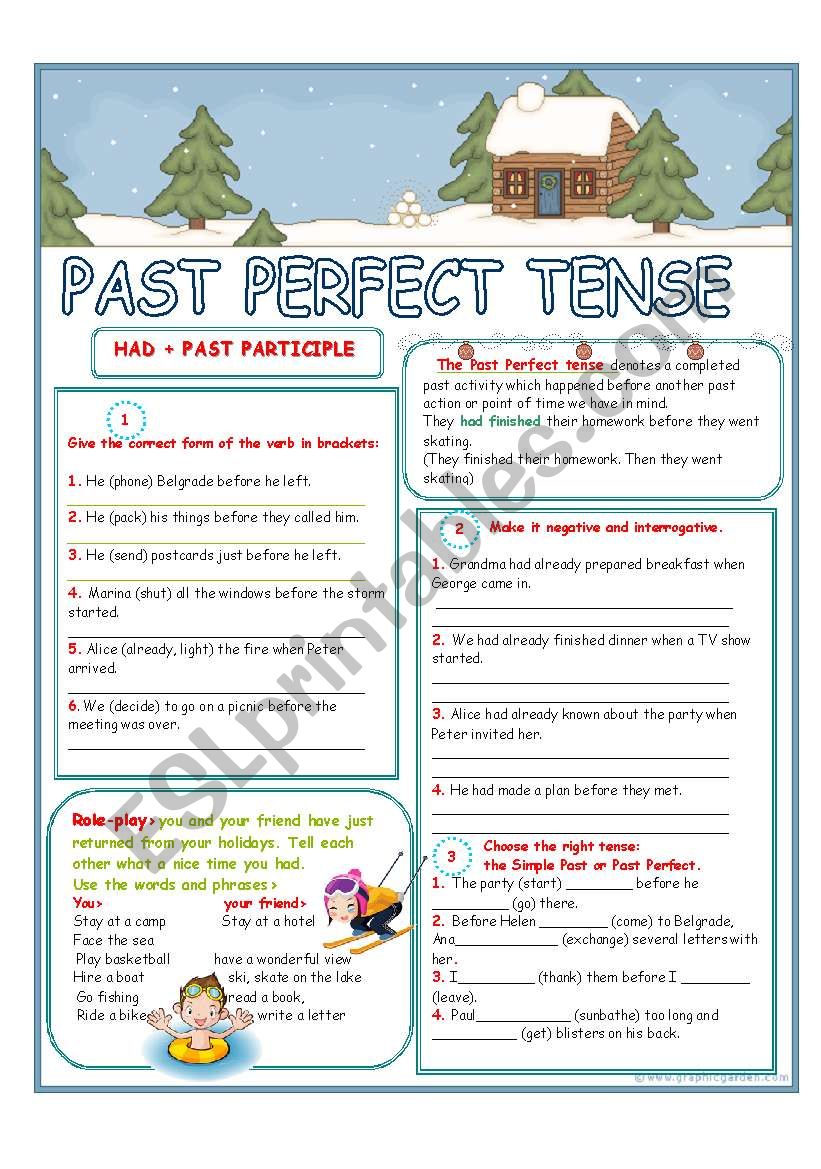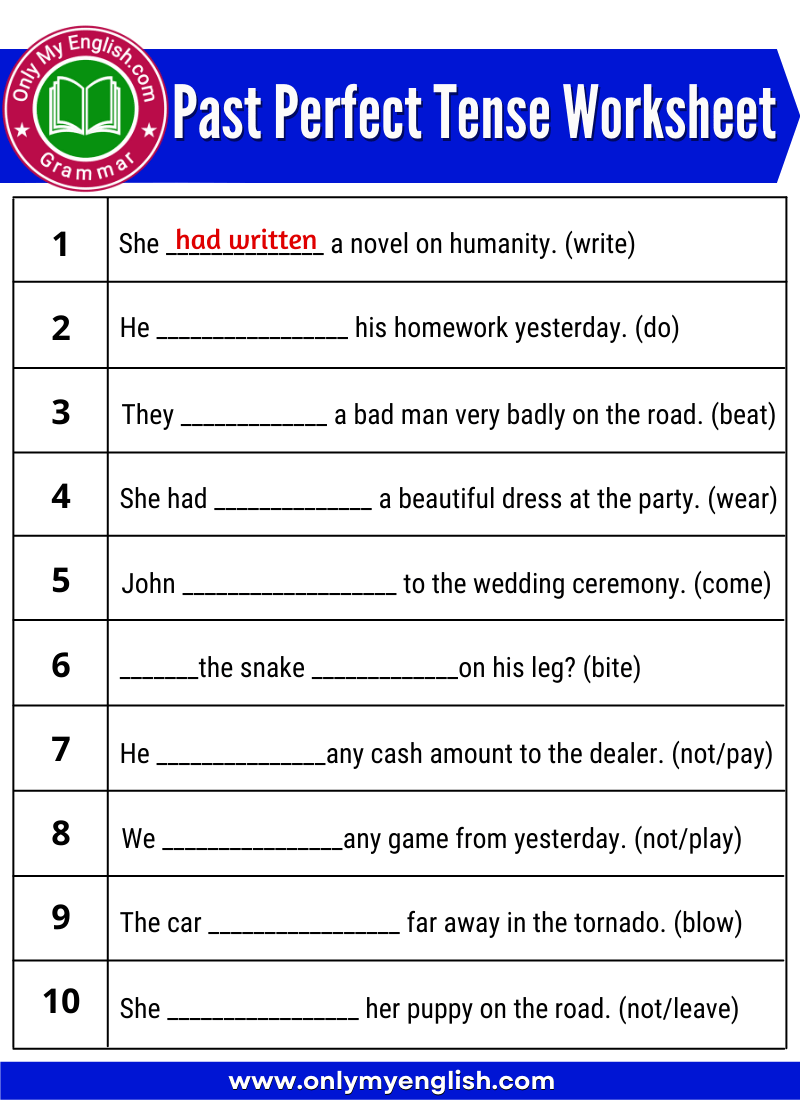
Mastering the Past Perfect: The Indispensable Role of Targeted Worksheets
The Past Perfect tense, a cornerstone of advanced English grammar, often presents a formidable challenge to language learners. Its nuanced application, indicating an action completed before another point or action in the past, requires precision and a deep understanding of temporal relationships. While theoretical explanations are crucial, true mastery hinges on extensive, deliberate practice. This is where well-designed Past Perfect worksheets become not just helpful, but absolutely indispensable tools in the language learning journey.
This comprehensive article will delve into the intricacies of the Past Perfect, explore the myriad benefits of incorporating worksheets into the learning process, highlight various types of effective Past Perfect worksheets, and provide strategies for their optimal use, ultimately empowering learners and educators alike to conquer this often-elusive grammatical structure.
Understanding the Past Perfect Tense: A Brief Review

Before diving into the utility of worksheets, it’s essential to briefly revisit the Past Perfect tense itself. Formed with "had" + the past participle (V3) of the main verb, it serves several key functions:

-

Action Completed Before Another Past Action: This is its most common use. It clarifies the sequence of events when discussing two actions that happened in the past, emphasizing which one occurred first.

- Example: "By the time we arrived, they had already eaten dinner." (Eating happened before arriving.)
-

Duration Before a Point in the Past: Similar to the present perfect, but shifted to the past. It describes an action that started in the past and continued up to another point in the past.
- Example: "She had lived in London for five years before she moved to Paris." (Living in London continued up to the point of moving.)


-

Reported Speech: When reporting what someone said in the past simple or present perfect, the tense often shifts to the past perfect in reported speech.
- Example: Direct: "I finished my homework." Reported: "He said he had finished his homework."
-
Third Conditional (Unreal Past Conditionals): To talk about hypothetical situations in the past that did not happen.
- Example: "If I had known you were coming, I would have baked a cake."

Common pitfalls include confusing it with the Simple Past, overusing it, or struggling with the correct sequencing of events. These are precisely the areas where targeted practice, facilitated by well-structured worksheets, can make a significant difference.
The Indispensable Role of Past Perfect Worksheets in Language Acquisition
Why are Past Perfect worksheets so critical for learners? The answer lies in their ability to provide structured, repetitive, and varied practice that reinforces understanding and builds fluency.
- Reinforcement of Concepts: After a theoretical lesson, worksheets offer the immediate opportunity to apply newly learned rules. This active engagement solidifies comprehension and helps transfer knowledge from short-term to long-term memory.
- Identification of Knowledge Gaps: As learners complete exercises, they (and their instructors) can quickly identify specific areas of confusion or persistent errors. This allows for targeted review and remediation, preventing misunderstandings from becoming ingrained habits.
- Development of Automaticity: Like any skill, grammar requires practice to become automatic. Worksheets provide the repetition necessary for learners to instinctively choose the correct tense without conscious effort, freeing up cognitive resources for more complex communication.
- Contextualized Learning: Beyond simple fill-in-the-blanks, many worksheets present the Past Perfect within meaningful contexts – short stories, dialogues, or scenarios. This helps learners understand not just how to form the tense, but when and why to use it in natural language.
- Self-Assessment and Progress Tracking: Worksheets often come with answer keys, allowing learners to check their own work and monitor their progress. This fosters autonomy and builds confidence as they see their accuracy improve over time.
- Preparation for Real-World Communication: The Past Perfect is vital for clear narrative and storytelling. Worksheets that encourage learners to construct their own sentences and narratives using the tense directly prepare them for more complex speaking and writing tasks.
In essence, worksheets bridge the gap between theoretical knowledge and practical application, transforming passive understanding into active proficiency.
Types of Effective Past Perfect Worksheets
The effectiveness of worksheets lies in their variety. A comprehensive approach utilizes different types of exercises to target various learning styles and reinforce different aspects of the Past Perfect.
-
Fill-in-the-Blank Exercises:
- Description: These are the most common. Learners complete sentences by conjugating a given verb into the Past Perfect.
- Example: "When I arrived, John ____ (leave)." (Answer: had left)
- Benefit: Excellent for reinforcing the basic form (had + V3) and initial recognition of the tense.
-
Sentence Combination/Transformation:
- Description: Learners combine two Simple Past sentences, using the Past Perfect to show the sequence.
- Example: "She finished her work. Then she went home." (Combine: "After she had finished her work, she went home.")
- Benefit: Crucial for understanding the sequencing function and developing complex sentence structures.
-
Error Correction Worksheets:
- Description: Learners are presented with sentences containing grammatical errors (often incorrect tense usage) and must identify and correct them.
- Example: "I felt tired because I didn’t sleep well." (Correction: "I felt tired because I hadn’t slept well.")
- Benefit: Develops critical thinking skills and helps learners internalize correct usage by actively identifying common mistakes.
-
Story Completion/Narrative Building:
- Description: Learners are given the beginning of a story or a set of prompts and must complete it, using the Past Perfect to describe background events or actions that occurred before the main narrative.
- Benefit: Promotes contextualized usage, encourages creative writing, and integrates the Past Perfect into meaningful discourse.
-
Matching Activities:
- Description: Learners match sentence halves, situations to appropriate Past Perfect sentences, or cause-and-effect clauses.
- Example: Match: "She couldn’t get into her house." with "She had lost her keys."
- Benefit: Reinforces cause-and-effect relationships and the logical application of the tense.
-
Question and Answer Prompts:
- Description: Learners answer questions that require the use of the Past Perfect, or formulate questions based on given answers.
- Example: "Why was he late?" (Answer: "He was late because his car had broken down.")
- Benefit: Encourages communicative practice and the active production of the tense in a conversational context.
-
"What Happened Before?" Scenarios:
- Description: Present a past situation, and learners must infer or describe what must have happened before that situation, using the Past Perfect.
- Example: "The street was wet." (Possible answer: "It had rained.")
- Benefit: Develops inferential reasoning and practical application of the tense for explaining past states.
A rich collection of Past Perfect worksheets will incorporate a blend of these types, ensuring a well-rounded and engaging learning experience.
Strategies for Maximizing the Impact of Past Perfect Worksheets
Simply handing out worksheets isn’t enough. Effective integration requires thoughtful planning and execution.
-
Pre-Worksheet Preparation:
- Clear Explanation: Always start with a clear, concise explanation of the Past Perfect’s form and functions, using plenty of examples.
- Contextualization: Briefly set the scene for the worksheet exercises. If it’s a story, introduce the characters or situation.
- Review Prerequisites: Ensure learners are comfortable with past participles and the Simple Past, as these are foundational.
-
During Worksheet Completion:
- Guided Practice First: Begin with a few examples completed together as a class or in pairs to ensure understanding of the task.
- Individual vs. Collaborative: Allow for individual work to assess personal understanding, but also incorporate pair or small-group work for peer learning and discussion. This allows learners to articulate their reasoning and learn from each other’s mistakes.
- Teacher Monitoring: Circulate the room, observe learners’ progress, and offer targeted assistance. Look for common errors to address later.
- Time Management: Set clear time limits for each activity to maintain focus and momentum.
-
Post-Worksheet Activities:
- Thorough Review: Go over answers as a class. Don’t just provide the correct answer; explain why it’s correct and why common errors are incorrect.
- Discussion and Elaboration: Encourage learners to explain their choices. For narrative exercises, have them read their stories aloud.
- Error Analysis: If a specific error is widespread, dedicate a few minutes to re-teaching that concept.
- Follow-Up Activities: Extend the learning beyond the worksheet. For example, if they completed a story, have them act it out, or write a sequel. Use the sentences from the worksheet as prompts for speaking activities.
-
Differentiation:
- Scaffolding: For struggling learners, provide word banks, partially completed sentences, or simpler tasks.
- Challenge: For advanced learners, encourage them to create their own sentences, write longer narratives, or explain the nuances of the Past Perfect in different contexts.
-
Constructive Feedback:
- Focus on progress, not just mistakes. Highlight what they did well.
- Provide specific, actionable feedback rather than just marking answers right or wrong. Explain why an answer is incorrect and how to improve.
Where to Find and How to Create Excellent Past Perfect Worksheets
The digital age offers a wealth of resources for Past Perfect worksheets.
- Online ESL Resources: Websites like ESL-Lounge, British Council LearnEnglish, Agendaweb, and many others offer free, printable worksheets covering various grammar points, including the Past Perfect. Many platforms also offer interactive online exercises.
- Textbooks and Workbooks: Traditional English language textbooks invariably include extensive exercises on the Past Perfect. Their structured approach often provides a logical progression of difficulty.
- Teacher-Sharing Platforms: Websites like Teachers Pay Teachers allow educators to share and sell their own creations, often providing highly creative and effective materials.
For educators, creating your own Past Perfect worksheets can be incredibly rewarding and ensures the material is perfectly tailored to your students’ specific needs and interests.
- Tailor to Context: Use themes, characters, or situations that are relevant and engaging for your learners (e.g., local history, current events, school life).
- Vary Exercise Types: Don’t just stick to fill-in-the-blanks. Incorporate a mix of the types discussed above.
- Provide Clear Instructions: Ambiguous instructions can lead to frustration. Be explicit about what learners need to do.
- Include Examples: Always provide one or two completed examples for each exercise type.
- Create an Answer Key: This is essential for self-correction and efficient grading.
- Focus on Authenticity: Whenever possible, use scenarios that mirror real-life language use. For instance, ask students to explain why someone was late, or describe a sequence of events leading up to a specific outcome.
Conclusion
The Past Perfect tense, while initially challenging, is an essential component of clear and sophisticated English communication. Its mastery unlocks the ability to narrate complex events, report speech accurately, and express nuanced temporal relationships. While classroom instruction provides the foundational knowledge, it is the consistent, varied, and contextualized practice offered by high-quality Past Perfect worksheets that truly solidifies understanding and builds fluency.
By strategically selecting diverse types of worksheets, implementing effective teaching strategies for their use, and encouraging both individual effort and collaborative learning, educators can transform a potentially daunting grammatical concept into an accessible and ultimately conquerable skill. Ultimately, the journey to Past Perfect proficiency is significantly paved by the dedicated engagement with well-crafted Past Perfect worksheets.
